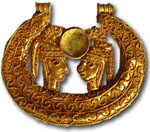
At the ancient necropolis (ninth to sixth century B.C.) of Orthi Petra at Eleutherna on Crete, archaeological excavations have verified the use of three burial practices: cremations, jar burials, and inhumations. Cremation was used mainly (98 percent of the time) for adult males of high social standing (princely warriors). As revealed by archaeological research, in the vast majority of cases the burial custom at Orthi Petra depicted an illustration of funerary rights as narrated in the Homeric poems, especially in the Iliad.
The other two varieties of burial customs, jar burials and inhumations, had been used for younger individuals--for children between birth and 16 years of age--for much older male individuals, and for women of lesser material wealth. One question that floated in our minds over the years had been: Where were the female princesses interred? Where were the women of significant social status in ancient Eleutherna?

Sacred Adornments
In this photo gallery, excavation director Nicholas Stampolidis describes 10 spectacular artifacts from the tomb of the priestesses at Eleutherna.
During the last two years, we excavated a series of three connected pithoi (very large ceramic vessels) containing the human remains of a sequence of a minimum of three generations. This discovery provided an answer to our question, given that within the pithoi, ranging in height from 5.25 to 6.56 feet, there were interred very richly adorned female individuals with common genetic characteristics.
The most important discovery of the 2009 season, however, was that of a building retaining a height of 7.55 feet, and measuring 9.19 x 10.50 feet in width and depth. The building featured a doorway at its western side constructed with elaborately carved and well-fitted stone slabs. After its functional use, the doorway had been blockaded by a barrier of hundreds of large stones.
The excavation of the building revealed nearly in its central position a stone table whereas at the eastern and slightly northern and southern area we unearthed a number of large amphorae, probably containing liquids (such as olive oil and wine), one of which was covered by a glass phiale of the kind used for pouring libations. Between the structure of the stone table and the amphorae, we recovered (on a western to eastern orientation) a number of exquisite bronze vessels of different typologies, a series of bronze phiale, bronze cups, and a bronze lamp; ceramic vases; the disk of a scale with its chain from which it had suspended; and much more.
Further to the eastern area within the building, a number of female skeletons (most probably four) were uncovered, adorned with burial artifacts: bead necklaces, scarabs, earrings, bracelets, etc., made of a variety of luxury materials: gold, silver, quartz, Egyptian blue, amber, semiprecious stones. Furthermore, a collection of unique golden jewelry with prophylactic functions was recovered, one of which depicts a god of beasts (with lions to both of his sides). Another shows the ventral view of a lion in predatory mode, another one shows two warriors facing each other; one reveals the protome of a female deity, and there are more. There was also a bronze statuette of a bull, a small bronze saw, and a very small bronze ladle. (See Sacred Adornments.)
As the cranium of the oldest female individual was recovered from the area of her pelvis--and if there shouldn't be any taphonomic disturbances that could explain this particular positioning--I believe that this woman was interred in a seated position as one may also consider the fact that under and around the bones the sediments contained organic materials (wood, etc.) and the nose remained intact, an unbelievable occurrence after approximately 2,700 years. In case the results of the study of the material around the head cannot explain this preservation, one could consider that it may indicate that this woman had undergone a "mummification" process or possibly a process that attempted to preserve aspects of her initial morphology.
The richness of the burial offerings, and particularly the golden pendants with the prophylactic functions--as well as the bronze saw, the ladle, and the statuette--point to women of high standing, most probably to priestesses, healers, or "sorcerers." The displays on the golden ornaments reflect on their relativity with these on the bronze "shields" found at the Idean Cave, situated on Mount Ida (also known as "Psiloritis," reaching an elevation of more than 8,000 feet) boasting at the southeast of Eleutherna the place of the birth, cult, and service of the ultimate of god of antiquity, the Cretan-born Zeus.
- For images of artifacts from the tomb of the priestesses, see Sacred Adornments.
Advertisement

Advertisement








